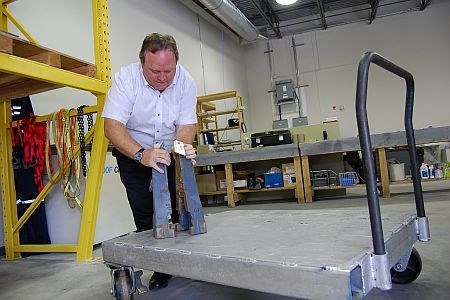Caked in layers of ice and frost, various pipes carry liquid nitrogen from a large outdoor tank on Sudbury's Maley Drive to Dura 21's special processor, cryogenically freezing the mining equipment that's been placed inside.
Over the course of several days, the temperature will drop to -300 Fahrenheit, realigning the equipment's molecular structure and making it more durable, extending its service life by at least 50 per cent.
"Typically, if a bearing lasts four months of service, often we can get it to last eight months, and in some cases, we've had pieces last three or four years," says Dave Dillon, director of research and development for Dura 21.
"Every application is different."
Having started 10 years ago with forging and stamping in southern Ontario's heavy manufacturing industry, the Niagara Falls-based company soon began to consider how the technology might be used in other, broader industries.
Given the wear rate of the tools to extract and process ore, as well as the concentration of potential clients, Sudbury presented a potentially strong market. After looking at the local mining industry from a Lively office for the last three years, Dura 21 moved into a 2,400-square-foot space in NORCAT's new Innovation and Commercialization Park in January 2009.
There, the two-man operation now receives and works on a variety of metals, from drill bits to bearings, from debarkers to rail ties.
The proprietary process, developed and continuously improved upon over the last decade, is repeatable and consistent "like a cake recipe," says Dillon. Over time, usually a minimum of three days, the process involves gradually lowering the material from room temperature down to -322 degrees Fahrenheit. Freezing an item too quickly will cause it to crack from thermal shock, ruining it.
Untested equipment is often shipped to Xstrata Nickel Process Support laboratories after it's been prepared, where it is tested against an unprepared sample to determine the potential gain.
This gain varies widely between items, depending on a variety of factors such as the composition of the metal, its application, and the environment in which it will be used. Even the abrasiveness of the rock can vary from one point to another just a few miles away, further complicating the predictability of results.
The company has built up their historical data over the years and it has shown that some types of metals react better than others, with tool steels providing the best results, says Dillon. Other favorable types include certain grades of stainless, aluminum and low-alloy steels.
Even ceramic bearings have seen strong returns, though bearings have generally been a strong performer, with some providing as much as a 500 per cent gain.
Although staff does its best to track the durability of the part after returning it to the customer, some clients who simply prefer to keep the extent of the gains to themselves, especially if proprietary metals are involved in their products.
"The only understanding we have that it in fact was positive is the fact that (the companies) reorder on a continual basis."
However, it's not the cost of the part itself that often proves to be the greatest advantage, he says, but rather the prevention of failure-related downtime. As an example, he points to one client who saved $400,000 by extending the life of a $1,700 part.
These and other successes are driving plans to hire two more people by the end of the year, and to one day potentially expand into a separate site outside of NORCAT.
"We're cautious, and we're going to take our steps very, very slowly. We've been doing this for 10 years, and if it takes a couple more years to do it right, I'd rather do that than hurry up, and that'll be our method of going forward, probably forever."
www.dura21.com




